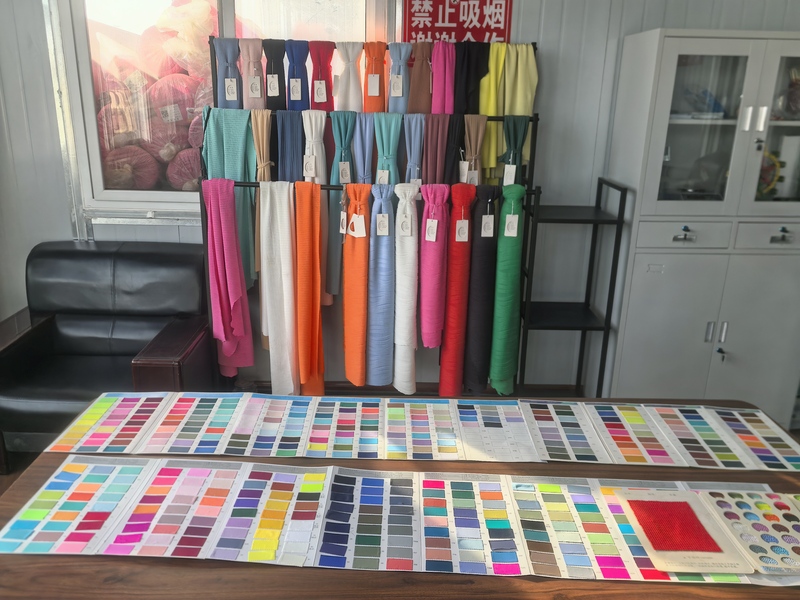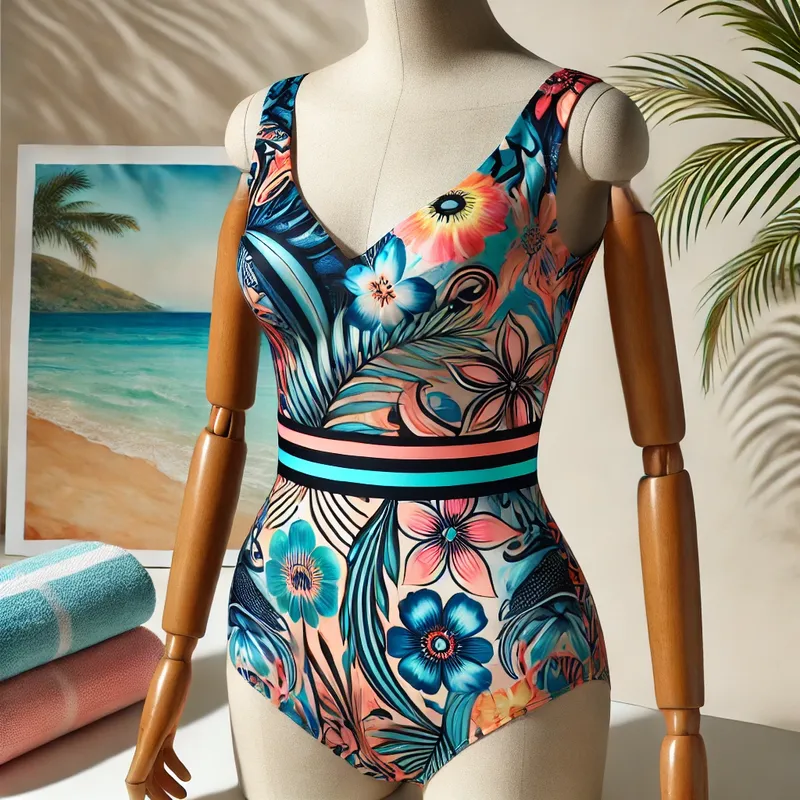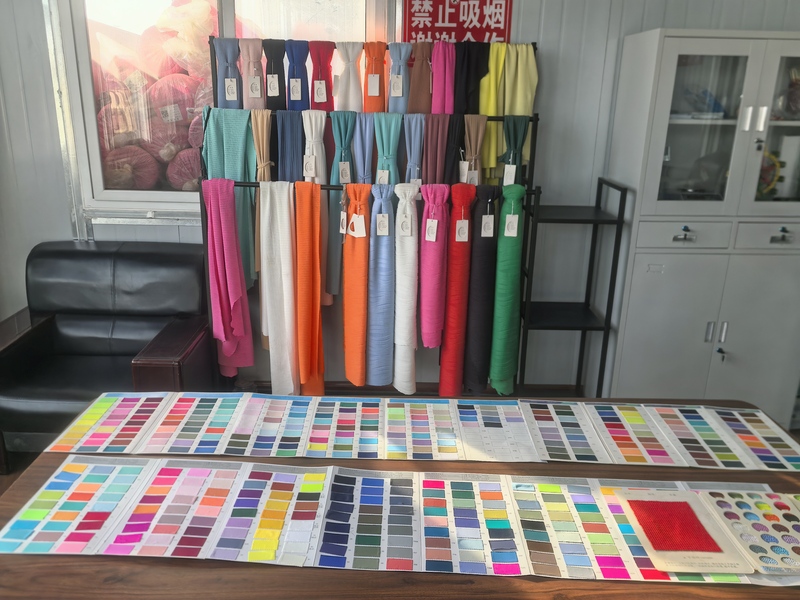Have you ever encountered these puzzling situations: Why do the sample swimsuits look or feel different from those in large batch orders? Why do some swimsuits in large batch orders have slight color differences? Or, why do the printed patterns on swimsuits seem consistent, but feel different when worn? These issues actually stem from the production and fabric management processes in swimwear factories. Only by gaining an in-depth understanding of the professional operations and key steps in swimwear factories can we gradually find answers and effectively resolve these problems.
Choosing the right swimwear fabric is crucial for swimwear factories to produce high-quality products. Consistency, functionality, and color management of fabrics need to be strictly controlled. Through refined process control and transparent communication, professional swimwear factories can provide customers with stable product quality and establish a foundation of trust for long-term cooperation.
Let's delve into the professional practices of swimwear factories in fabric selection and management, and learn how to ensure consistency between bulk fabrics and sample garments, maintain fabric backups, conduct functional tests, and solve swimwear color and printing issues. This will help you better understand the key aspects of swimwear production and choose a trustworthy partner.

I. How to ensure complete consistency between bulk fabrics and sample garments?
In the swimwear production process, we are well aware of the high standards that buyers have for consistency between samples and bulk orders. This not only relates to the appearance of the product but also directly affects the customer experience and the market performance of the brand. To ensure consistency between bulk fabrics and sample garments, we exercise strict control in the following aspects:
1.Color consistency: Start from the source
The impact of dyeing process on color consistency:Whether fabric colors are consistent depends on the dyeing process and dye vat management. Dyeing factories are usually divided into large vats (100-300 kilograms) and small vats (below 100 kilograms). Inevitably, there will be color differences between different batches of dyeing, which is a common phenomenon in the industry.
Our countermeasures
Before production, we clearly inform you of potential color difference issues and discuss solutions with you.
For orders with extremely high requirements for color consistency, we recommend using a one-time customized dyeing method to ensure that the fabrics for the entire order come from the same batch.
After each dyeing sample is made, the factory will keep three samples: one for customer confirmation, one for self-retention and comparison, and one for the fabric supplier to keep as a backup, ensuring subsequent traceability.
2.Print consistency: Pay attention to the importance of base fabric
Not only the patterns but also the base fabrics are printed Many buyers easily overlook the consistency issue of printed base fabrics. Printing factories usually use white greige fabric as the base, and the sources of these greige fabrics may change due to different batches. Even if the printed patterns are consistent, differences in the material and hand feel of different base fabrics will affect the final effect of the swimsuit.
Our countermeasures
During sampling, we pay special attention to the source of the printed base fabric, require the printing factory to provide greige fabric samples, and keep backups.
Before bulk production, we repeatedly confirm with the printing factory to ensure that the base fabric remains consistent with the sample fabric. When necessary, we also require the printing factory to separately stock the same batch of base fabric for production.
3.Material and composition consistency: Standardization and testing
Why is material consistency crucial?Swimwear is not only a visual product but also functional apparel. Differences in materials may directly affect the key properties of swimwear, such as elasticity, quick-drying, and chlorine resistance. If the materials are inconsistent, even if the colors and patterns match, it will affect the actual user experience of the product.
Our countermeasures
Before purchasing bulk fabrics, all materials will be strictly checked against the material composition and performance requirements of the sample garment fabrics.
Suppliers are required to provide material test reports, and internal testing is arranged to ensure that the bulk materials are completely consistent with the sample garment materials.
Through the above measures, we not only ensure the consistency of samples and bulk goods but also help buyers reduce communication costs and market risks caused by quality issues. This is our commitment to quality and the cornerstone of our long-term cooperation with buyers.
II. Why is it important to keep fabric backups?
The importance of fabric backups goes without saying. In my view, fabric backup retention is not only a key step in the production process but also an important means to ensure order quality and customer satisfaction.
1.Backups and customer confirmation go hand in hand, ensuring traceability at every step
In the production process of swimwear orders, we synchronously confirm samples with customers. Before the customer confirms the final version of the sample, we back up the fabric to ensure that there is a reference for each step. This is not only for quickly responding to the customer's modification requirements but also for ensuring that the bulk production is carried out strictly in accordance with the confirmed sample standards.
How do we operate?
After each sampling, at least two backup fabrics are retained: one for production reference and one for file preservation.
Backup fabrics record detailed information, including supplier, batch number, material, color, and purpose, to ensure that any problems can be quickly traced back to the source.
2.The relationship between backup archiving time and final confirmation
The retention time of fabric backups is usually consistent with the customer's confirmation time point. Until the customer confirms the final version of the sample, we will archive the fabric backup and standardize the sample into a document or electronic record.
Why do this?
Avoid chaos in bulk production due to changes in customer requirements.
Once a quality problem occurs, the difference between the sample and the bulk goods can be quickly compared to clarify responsibilities and resolve the issue in a timely manner.
3.The extra assurance brought by backups
Backup fabrics are not only a guarantee for current orders but also a reference and accumulation for future orders. For long-term cooperative customers, backup records can also help us quickly understand customers' preferences and needs, shortening the communication time in the early stages of production.
Real case sharing We once had a long-term cooperative customer who needed to repurchase the same fabric for a supplementary order because the fabric used in a certain batch of orders had been used for a long time. Thanks to our complete backup system, we quickly found the fabric records at the time and contacted the supplier to repurchase, ensuring that the supplementary order products were completely consistent with the original order. The customer was very satisfied with our efficiency and quality.
Fabric backup may seem like a simple process, but it can effectively improve the stability and controllability of swimwear orders, bringing more guarantees and trust to both buyers and factories. This is also the reason why we always adhere to this practice.
III. Fabric functionality testing and quality assurance
In addition to having an outstanding appearance, the functional performance of swimwear fabrics is also crucial. In our factory, functionality testing is an indispensable part of fabric management, especially for swimwear orders with high requirements.
1.Color fastness testing: Ensuring the visual durability of fabrics
Swimwear often needs to face harsh environments such as water, sunlight, and washing. The quality of color fastness directly determines the service life and visual effect of swimwear.
Our testing focus
Washing fastness: Ensure that the fabric does not fade during the washing process.
Light fastness: Especially in beach or swimming pool environments, ensure that colors do not fade after exposure to strong sunlight.
Chlorine resistance: Swimwear often comes into contact with chlorides in pool water, and it must be ensured that the fabric does not fade or become damaged due to chlorine corrosion.
Our practices
Before purchasing bulk fabrics, each batch is sent to professional institutions for color fastness testing.
Suppliers are required to provide test reports that meet the standards and clearly state the guarantee clauses in the contract to ensure that suppliers are responsible for fabric quality.
2.Testing and certification of special functional fabrics
Some customers have special functional requirements for fabrics, such as UV resistance, moisture wicking, quick drying, antibacterial and odor resistance. These fabrics have higher requirements for production and testing.
How to ensure that functional fabrics meet the standards?
Require fabric suppliers to provide professional certifications (such as UV resistance index test certificates, antibacterial test reports) before delivery.
In the factory, we conduct spot checks and simulate real use environments (such as soaking in water, rapid drying, etc.) to re-verify the functionality of the fabrics.
3.The significance of functionality testing
Reduce risks:Discover and solve potential quality problems of fabrics in advance, avoiding returns or complaints due to substandard functionality after bulk production.
Enhance customer trust :Complete testing procedures and reports can enhance buyers' trust in us, especially for high-end swimwear brands, functionality is an important criterion for them to choose suppliers.
Case sharing
We once produced a batch of high-end swimwear with UV-resistant functions for a European and American customer. In the early stage of the order, the customer required strict UV resistance performance testing. We not only provided the supplier's certification certificate but also discovered in our internal re-inspection that the UV resistance performance of a batch of fabrics provided by the supplier was slightly lower. After communication, we assisted the customer in re-selecting higher-quality fabrics, ultimately ensuring the quality of the order.
Functionality testing is not only a check on order quality but also a manifestation of the factory's professionalism. We always adhere to high-standard testing and control to provide customers with trustworthy products.
IV. In-depth analysis and solutions to swimwear fabric color issues
As a swimwear factory manager, I must admit that swimwear color issues are one of the most challenging parts of the production process. Whether it's dyeing techniques, printed base fabrics, or color control in multi-batch production, they can all affect the stability of the finished product's color. Here is our in-depth analysis and solution to color issues.
1.The challenges of color consistency
Dye vat batch differences :The consistency of fabric color is mainly affected by the dyeing process. Dyeing factories use large dye vats (100-300 kilograms) or small dye vats (below 100 kilograms) for dyeing. Even if the same dye formula is used, fabrics produced in different dye vats may still have slight color differences due to differences in dyeing conditions. This is especially common in large batch orders that require multiple vats to work together.
The complexity of different colors Some colors: are highly sensitive to light and angle, such as dark colors (like black and dark blue) that are prone to producing different shades due to subtle changes in dye formulas. Even for a simple black, there may be various forms such as "jet black", "bluish black", and "grayish black". This characteristic is not unique to black but is a phenomenon that may exist in all colors.
The latent influence of printed base fabrics: Printing factories usually purchase large quantities of white greige fabrics for printing, and these greige fabrics may come from different suppliers. Even if the pattern colors are consistent, differences in the material, thickness, or texture of different batches of greige fabrics will affect the hand feel and overall visual effect of the finished product.
2.Our countermeasures
Control dye vat issues from the source
At the beginning of the order, clearly inform the customer of the slight color differences that may be caused by dye vats, and recommend that large orders complete dyeing in one batch as much as possible to avoid cross-batch color differences.
For orders with extremely high requirements for color consistency, we recommend that customers adopt a customized dyeing plan, where the supplier uniformly dyes in batches and provides multiple rounds of sampling for confirmation. After confirming the sample fabric, the factory will keep three sample fabrics: one for customer confirmation, one for self-retention and archiving, and one for the supplier as a comparison standard.
Solution strategies
In an order involving a large batch of dark-colored fabrics, we found that due to production in multiple dye vats, the colors showed subtle differences. By quickly activating the backup sample fabric plan, all fabrics were classified and compared, and ultimately the batches closest to each other were selected and uniformly used for bulk production, successfully solving the problem.
Similar strategies are also applicable to other colors, such as dark blue, bright yellow, and other color-sensitive color systems.
Consistency guarantee of printed base fabrics
In the printing sampling stage, we require the printing factory to record the source and batch of the base fabric and provide sample fabric backups.
During bulk production, priority is given to base fabrics with the same material as the sample fabric. When necessary, multiple batches of base fabric samples are provided for customer confirmation to ensure stable printing effects.
3.Customer communication and file management
Transparent communication : At the beginning of the order, we fully communicate with customers about the potential risks of color issues, set reasonable expectations in advance, and propose corresponding solutions to avoid misunderstandings or disputes in the later stages.
Standardized file management : All order color sample fabrics and production information are archived, including detailed records such as supplier, dye vat number, and batch number. Future supplementary orders or re-examination can be quickly traced to ensure consistency between new orders and historical orders.
4.Summary of solutions to swimwear color issues
Advance planning and communication: Clearly inform customers of potential slight color difference issues in dyeing and printing processes, and propose feasible solutions.
Strict control of production and comparison processes: Ensure color consistency through multiple samplings, archiving, and multi-batch comparisons.
File management aids the future: Establish customer color sample files to quickly solve current problems and provide references for future orders, improving efficiency and consistency.
Through the above methods, we can not only effectively control swimwear color issues but also provide customers with professional and efficient services, ensuring that the color quality of each batch of orders is consistent with customer expectations. This is not only a manifestation of the factory's professionalism but also the key to establishing long-term trust with customers.
V. Printing fabric issues and countermeasures
In my communication with buyers, I often hear this question: Why do the printed colors seem fine, but always feel a bit different when the swimsuit is worn? Printing may seem like a simple process, but the base fabric, printing techniques, and color control involved can all bring challenges. Here is our in-depth analysis and solution to printing issues.

1.The essence of printed color issues
Why are printed colors usually more stable? Compared with dyeing, the colors of prints are directly printed on the fabric and usually undergo strict color control, so there are fewer obvious color difference issues.
The impact of base fabrics : The white greige fabric used by printing factories is the foundation, but these greige fabrics may come from different suppliers, and there may be slight differences in material, weaving, and even color between batches. These differences may cause the printed finished products to be inconsistent with the samples in terms of visual effect or touch.
2.How to ensure the consistency of base fabrics?
Backup white greige fabrics In the sampling stage, we require the printing factory to provide white greige fabrics consistent with the sample fabric, and at the same time back up two to three pieces of sample fabric for customer confirmation, self-retention, and archiving, respectively.
Targeted purchasing of base fabrics For high-standard orders, we specify the printing factory to purchase greige fabrics that are completely identical to the sampling, and require them to maintain the same batch of supply during bulk production to minimize the risk of base fabric differences.
3.Control of the printing process
Process clarification : The printing factory is only responsible for printing the design pattern on the greige fabric, while the source and quality of the greige fabric are strictly controlled by us. Therefore, before formal printing, we communicate with the printing factory to confirm the process and ensure that the base fabric, color, and pattern fully meet the requirements.
Multiple proofreading and sampling : Sampling is not only to confirm the printing color but also to check the overall effect of the base fabric and finished product. After confirming the sample fabric, we repeatedly check the base fabric and finished product to ensure consistency.
4.Special situation handling: Emergency plan for base fabric changes
Rapid response when changes occur : If the printing factory causes batch changes in the base fabric due to force majeure, we immediately communicate with the customer and provide a new printed sample fabric for customer confirmation. Production will only continue after customer confirmation to avoid blindly pushing forward and causing order quality problems.
5.Case sharing of printing issues
We once received a large batch printing order where the customer had extremely high requirements for color and pattern. During bulk production, we found that the base fabric purchased by the printing factory had slight material differences from the sample fabric. Although the pattern printing effect was consistent, the hand feel of the finished product was slightly different. By quickly activating our backup plan and finding the same greige fabric as the sample for reproduction, we not only made up for the time but also made the customer very appreciative of our professionalism.
6.Core points of print management
Focus on base fabrics, prioritize ensuring consistency : The material and batch control of base fabrics is the key to print consistency.
Multiple backups to ensure traceability : Through multiple sample fabric backups and detailed file records, quickly respond to potential problems.
Communicate in advance to reduce misunderstandings and risks : Fully communicate potential risk points with customers before printing to ensure that customer expectations are consistent with actual effects.
Printing issues may seem like details, but they can affect the overall quality of the order. Through strict base fabric management, process control, and emergency plans, we provide customers with more efficient and stable solutions, reflecting the swimwear factory's pursuit of quality.
the foundation of swimwear production and the core link to ensure order quality and customer satisfaction. From the consistency of bulk fabrics and sample garments to fabric backup archiving, functionality testing, color management, and print control, each link requires highly professional execution and meticulous management.
Through refined process control and transparent communication, we not only provide customers with stable product quality but also establish a foundation of trust for long-term cooperation. Choosing a professional swimwear factory is not only a guarantee of product quality but also a responsibility for brand reputation. We look forward to joining hands with each customer to maintain competitiveness and advantage in the swimwear market.
If you are interested in the workflow of a swimwear factory, feel free to explore our other blog posts on our website, such as:
